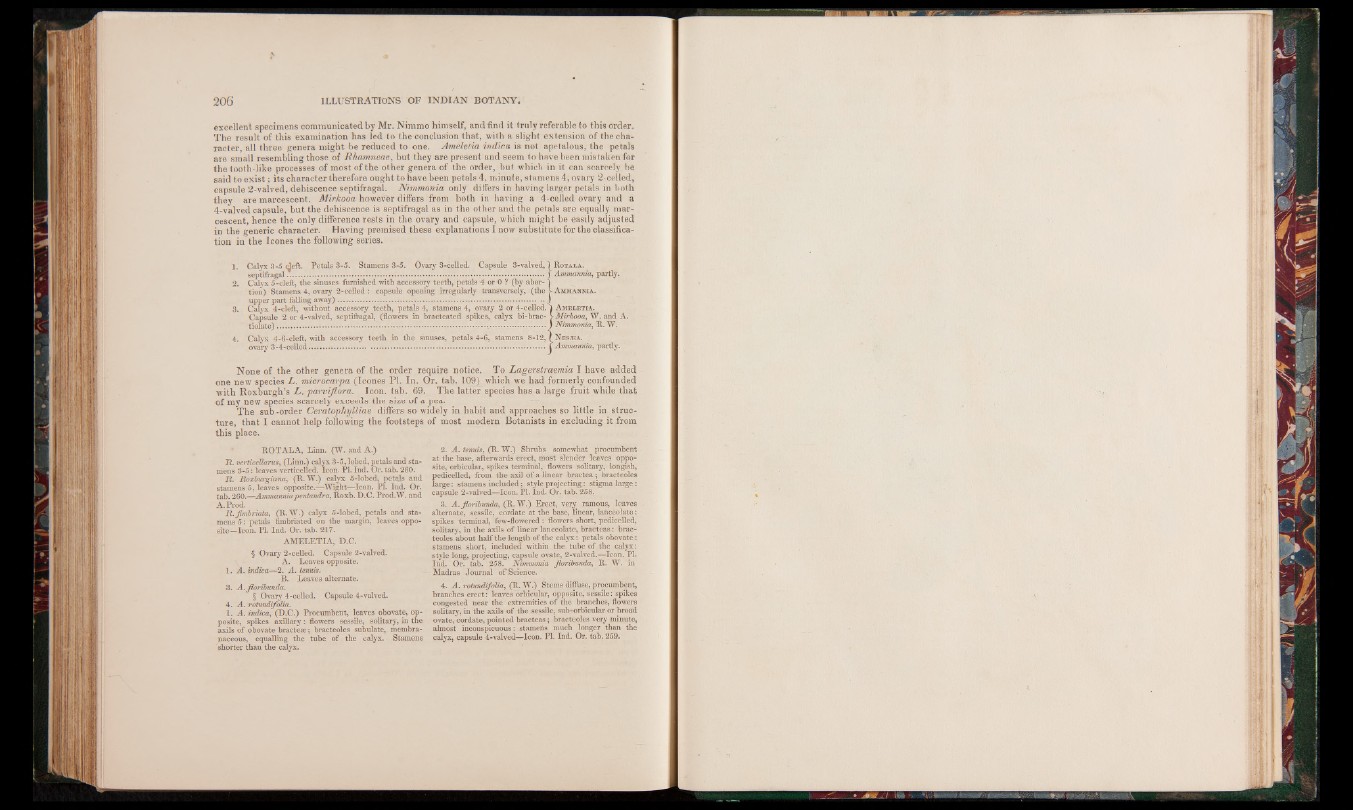
excellent specimens communicated by Mr. Nimmo himself, and find it truly referable to this order.
The result of this examination has led to the conclusion that, with a slight extension of the character
all three genera might be reduced to one. Ameletia indica is not apetalous, the petals
are small resembling those of Rhamneae, but they are present and seem to have been mistaken for
the tooth-like processes of most of the other genera of the order, but which in it can scarcely be
said to exist; its character therefore ought to have been petals 4, minute, stamens 4, ovary 2 -celled,
capsule 2-valved, dehiscence septifragal. N im m o n ia only differs in having larger petals in both
they are marcescent. Mirkooa however differs from both in having a 4-celled ovary and a
4-valved capsule, but the dehiscence is septifragal as in the other and the petals are equally marcescent,
hence the only difference rests in the ovary and capsule, which might be easily adjusted
in the generic character. Having premised these explanations I now substitute for the classification
in the leones the following series.
1. Calyx 3-5 deft. Petals 3-5. Stamens 3-5. Ovary 3-celled. Capsule 3-valved, 1 R otala.
septifragal?...............................................................................................................................) Ammannia, partly.
2. Calyx 5-cleft, the sinuses furnished with accessory teeth, petals 4 or 0 ? (by abor-1
tion) Stamens 4, ovary 2-celled: capsule opening irregularly transversely, (the > A mmannia.
upper part falling away)....................................................................................... .............. )
3. Calyx 4-cleft, without accessory teeth, petals 4, stamens 4, ovary 2 or 4-celled. "1 Amuletia.
Capsule 2 or 4-valved, septifragal, (flowers in bracteated spikes, calyx bi-brac- \Mirkooa, W. and A.
tiolate)........................................................................ ............................................................ J Nimmonia, R. W.
4. Calyx 4-6-cleftj with accessory teeth in the sinuses, petals 4-6, stamens 8-12, ( Nesjea.
ovary 3-4-celled.................................................................................................................... j Ammannia, partly.
None of the other genera of the order re
one new species L . microcarpa (leones PI. In. (
with Roxburgh’s L . pa rviflo ra . Icon. tab. 69.
of my new species scarcely exceeds the size of a
The sub -order Ceratophylliae differs so w
ture, that I cannot help following the footsteps
this place.
ROTALA, Linn. (W. and A.)
R . verticellarus, (Linn.) calyx 3-5, lobed, petals and stamens
3-5: leaves verticelled. Icon. PI. Ind. Or. tab. 260.
R . Roxburgiana, (R. W.) calyx 5-lobed, petals and
stamens 5 , leaves opposite.—Wight—Icon. PI. Ind. Or.
tab. 260.—Ammanniapentandra, Roxb. D.C. Prod.W. and
A. Prod.
R.fimbriata, (R.W.) calyx 5-lobed, petals and stamens
5: petals fimbriated on the margin, leaves opposite
-ic o n . PI. Ind. Or. tab. 217.
AMELETIA, D.C.
§ Ovary 2-celled. Capsule 2-valved.
A. Leaves opposite.
1. A . indica—2. A . tennis.
B. Leaves alternate.
3. A.fioribunda.
§ Ovary 4-celled. Capsule 4-valved.
4. A . rotundifolia.
1. A . indica», (D.C.) Procumbent, leaves obovate, opposite,
spikes axillary : flowers sessile, solitary, in the
axils of obovate bractese; bracteoles subulate, membranaceous,
equalling the tube o f the calyx. Stamens
shorter than the calyx.
quire notice. To L a gerstraemia I have added
Jr. tab. 109) which we had formerly confounded
The latter species has a large fruit while that
pea.
idely in habit and approaches so little in struc-
of most modern Botanists in excluding it from
2. A . tenuis, (R. W .) Shrubs somewhat procumbent
at the base, afterwards erect, most slender leaves opposite,
orbicular, spikes terminal, flowers solitary, longish,
pedicelled, from the axil of a linear bractea; bracteoles
large: stamens included; style projecting: stigma large:
capsule 2-valved—Icon. PI. Ind. Or. tab. 258.
3. A.fioribunda, (R. W .) Erect, very ramous, leaves
alternate, sessile, cordate at the base, linear, lanceolate:
spikes terminal, few-flowered : flowers short, pedicelled,
solitary, in the axils of linear lanceolate, bracteas: bracteoles
about half the length of the calyx: petals obovate:
stamens short, included within the tube of the calyx:
style long, projecting, capsule ovate, 2-valved.—Icon. PI.
Ind. Or. tab. 258. Nimmonia fioribunda, R. W. in
Madras Journal of Science.
4. A . rotundifolia, (R. W.) Stems diffuse, procumbent,
branches erect: leaves orbicular, opposite, sessile: spikes
congested near the extremities of the branches, flowers
solitary, in the axils of the sessile, sub-orbicular or broad
ovate, cordate, pointed bracteas; bracteoles very minute,
almost inconspicuous: stamens much longer than the
calyx, capsule 4-valved—Icon. PI. Ind. Or. tab. 259.